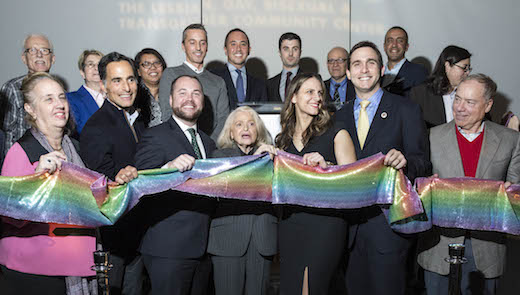 |
| A ribbon-cutting ceremony for the re-launch of the LGBT Center in New York City. Photo: Alex Geana. |
The space simply works better. For example, the acoustics are vastly improved. This might not seem like a big deal, but I’ve attended meetings there and had a hard time hearing people, even in the smaller rooms when fewer than 10 people gathered (some of them senior citizens). Problems like that are now solved.
This is important because the Center is home to numerous groups and services, including ones for people living with HIV. (Check out those offerings by clicking here and scrolling down.) In fact, legendary AIDS activist group ACT UP got its start at the Center, as did the Callen-Lorde Health Center and the Anti-Violence Project.In its three decades, the Center has provided for the evolving needs of the LGBT community, offering social services, counseling, recovery meetings, a computer lab, youth activities and family programs (helping gay couples have children and then offering the families a place to meet), and of course providing general meeting spaces for entertainment and socializing.
Now that the Center looks better and functions better, it will further enhance the experiences of its users. And that means a stronger and more empowered community.
From the beginning, HIV/AIDS was a big part of the Center’s foundation. The building was acquired in the early 1980s, as the epidemic was first hitting New York, and it was understood the Center would cater to the immediate crisis.
But the Center’s founders envisioned something grander than a four-story triage unit. Speaking to a crowd at a ribbon-cutting ceremony for the re-launch, executive director Glennda Testone said that the founders wanted to build a community center for “the generation after AIDS.” That generation might not be here yet, she said, but we’re making sure the Center will be here for them.
Also at the ribbon-cutting ceremony, New York City Comptroller Scott Stringer recalled that in the 1980s, President Reagan and the powers-that-be were not forthcoming with information about the epidemic, and that as a result people affected by HIV had to take matters into their own hands--having a meeting place like the Center was pivotal to their success.
New York City Council Speaker Melissa Mark-Viverito told the crowd that she had witnessed firsthand why a place like the Center is needed. She’s from Puerto Rico, which is more conservative on issues like gay rights, and says that once her family moved to New York, two of her brothers were able to come out as gay because they found a supportive LGBT community in the city.
And New York City Councilmember Corey Johnson noted that as an HIV-positive person who is now sober and in recovery, he understands that the Center saves lives and continues to save lives.
As heartfelt and important as these testimonies were, none was more powerful than the story told by Edie Windsor. Of course, everyone knows this trailblazer from United States v. Windsor, the 2013 Supreme Court case that made it illegal for the federal government to discriminate against gay married couples.
What you might not know is that she and her wife, Thea, were big supporters of the LGBT Center from its very inception and that the growth of the Center parallels her own coming out story.
But why not listen to her tell the empowering story? Glenn Zuraw recorded the speech and posted it on YouTube. Trust me, watch this 10-minute video and your day will be richly rewarded. Oh, and have a tissue handy. Especially for the part when she talks about the Center’s new Think Coffee café.
In the meantime, below are several before/after photos of the Center’s new look.
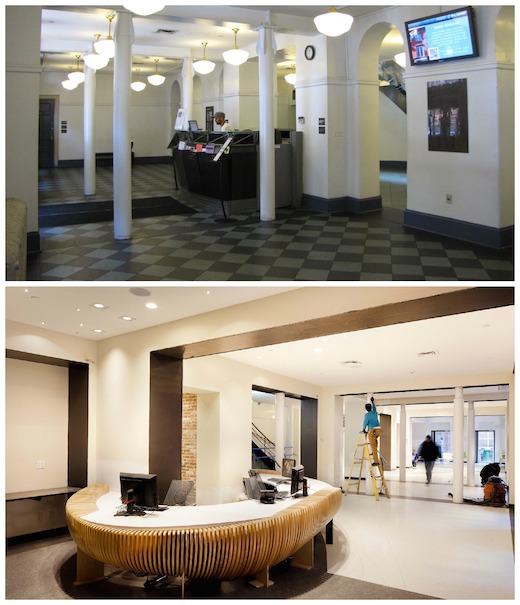 Above: Before and after images of the new lobby. (All of the “after” photos are by Travis Mark.) The renovation team included Brian Ripel of RSVP Architecture Studio PLLC and Nicola Mongelli of N-Plus Architecture and Design.
Above: Before and after images of the new lobby. (All of the “after” photos are by Travis Mark.) The renovation team included Brian Ripel of RSVP Architecture Studio PLLC and Nicola Mongelli of N-Plus Architecture and Design.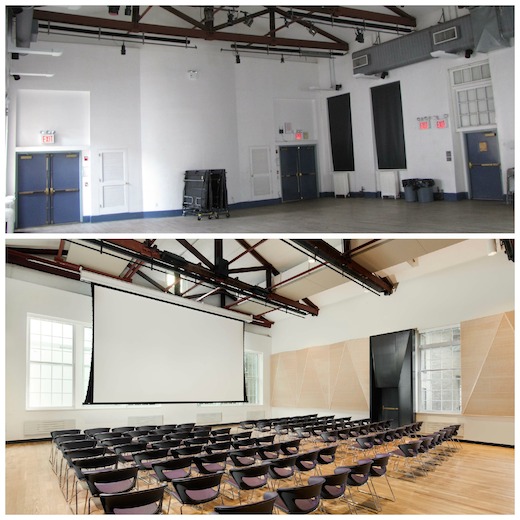 Above: Before and after images of the Lerner Auditorium. A floating floor and acoustic treatments enhance this multipurpose space.
Above: Before and after images of the Lerner Auditorium. A floating floor and acoustic treatments enhance this multipurpose space.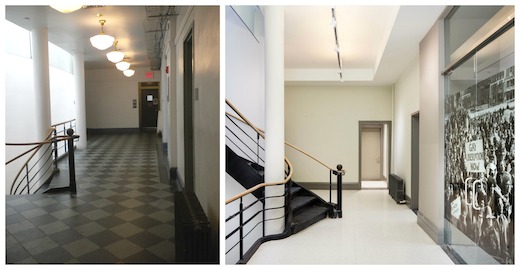 Above: Before and after images of the Center’s corridors. The renovation was a $9.2 million project made possible by city and state grants ($4.6 million and $2 million, respectively) and private contributions ($2.6 million).
Above: Before and after images of the Center’s corridors. The renovation was a $9.2 million project made possible by city and state grants ($4.6 million and $2 million, respectively) and private contributions ($2.6 million).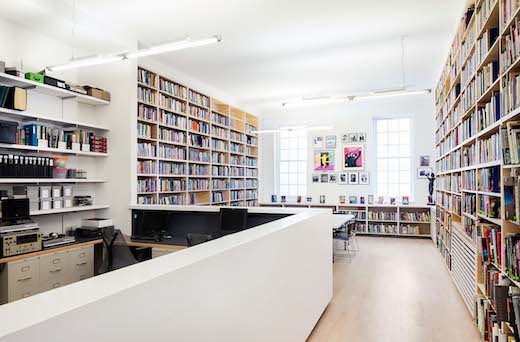
Above: The Pat Parker/Vito Russo Center Library and the Center’s National History Archive. In her speech, Edie Windsor said she decided to leave her records with this archive.
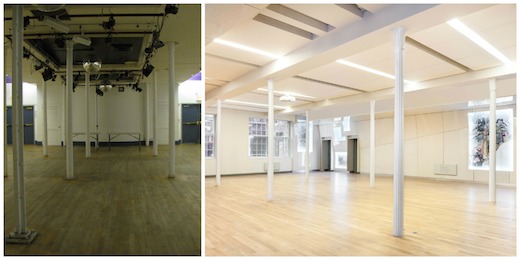 Above: Before and after images of Kaplan Assembly Hall. The drop-ceiling and several of the cast iron columns were removed, and the blocked windows were uncovered and replaced with sound insulated windows. In 1989, the Center hosted a historic art show--many of the works were done on the walls--and this renovation preserved those pieces by framing them in acoustic panels and illuminating them in LED lighting.
Above: Before and after images of Kaplan Assembly Hall. The drop-ceiling and several of the cast iron columns were removed, and the blocked windows were uncovered and replaced with sound insulated windows. In 1989, the Center hosted a historic art show--many of the works were done on the walls--and this renovation preserved those pieces by framing them in acoustic panels and illuminating them in LED lighting. Until April 6, visitors at the Center can check out the art exhibit Once Upon a Time and Now, on display throughout the building. Curated by Ian Alteveer, the show includes many of the works from the Center’s 1989 show along with recent works.
And yes, the famous Keith Haring bathroom mural is well preserved. Titled “Once Upon a Time,” this stunning piece is definitely NSFW at most any time. As we approach the 25th anniversary of Haring’s death on February 16, I’ll have more details on this jaw-dropping and joyous artwork.
UPDATE: Check out a dizzying video of the mural in my blog post "WATCH: Keith Haring’s NSFW Celebration of Gay Male Sexuality."







Comments
Comments